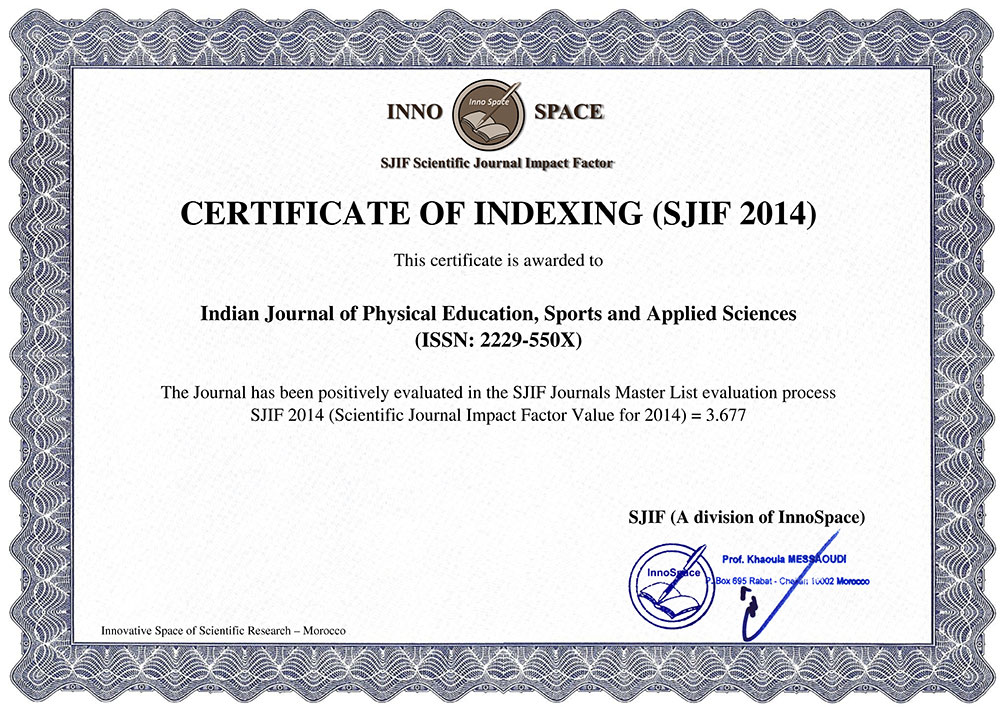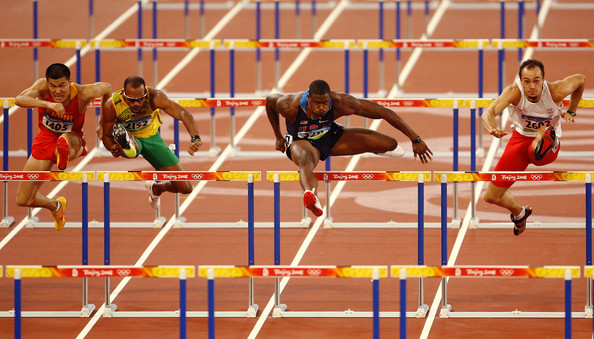SELF ESTEEM AMONG EARLY ADOLESCENT ATHLETES AND NON ATHLETES
Volume 7-Number 2, April, 2017 May 15, 2017| Author name : | Chindu Mary Mathew ,Mrs. Anu Anns Pious, & Dr. Sheela Rosalyn | ||||
|---|---|---|---|---|---|
| Page no : | 01-09 | Volume : | 7 | Issue : | 2 |
doi no.: 05.2017-56531957 DOI Link ::http://doi-ds.org/doilink/05.2017-56531957/
Chindu Mary Mathew 1,Mrs. Anu Anns Pious2, & Dr. Sheela Rosalyn3
Affiliations:
1 Students (M.Sc.) Psychological Counseling, Institution: Indian Institution of Psychology and Research (IIPR) Bangalore (Karnataka).
2 Assistant Professor. Institution: Indian Institution of Psychology and Research (IIPR) Bangalore (Karnataka).
3 Assistant Professor. Institution: Indian Institution of Psychology and Research (IIPR) Bangalore (Karnataka).
ABSTRACT
The aim of the present study was to compare self-esteem among early adolescent athletes and non-athletes. Sport participation has been shown to positively influence self – esteem of early adolescent. This effect was measured in sample of early adolescents, with the effect of gender; participation and level of participation in sports were explored. The participants in this study were 187 early adolescent where 89 non-athletes (43 males and 46 females) and 98 athletes (51 males and 47 females) between in the Grades 5-8. The athletes are further divided into two groups of 50 recreational/ fun athletes and 48 competitive athletes. The sample was collected through non- random sampling method. Rosenberg scale of self – esteem was used to measure participants Self –esteem. Through the Descriptive statistics and Independent Sample t- Test the following results were concluded. The results showed the athletes have significantly higher self – esteem compared to non- athletes. Also, competitive athletes have higher self- esteem than recreational athletes. It was also found that there is no gender difference in self – esteem among early adolescent athletes.
Keywords: sports, self-esteem, type of participation, levels of participation.
DOWNLOAD FULL TEXT: 
BIBLIOGRAPHY
Amac, Z., Anastasio, N , Morwick, A., & Yi. J. (2002). Girls’ Self-Esteem Comparison in Competitive and Recreational Gymnastics (Research Report No. Y520 ). Retrieved from Indiana University website: http://www.indiana.edu/~educy520/sec5982/week_15/zanaamjy.pdf
Ahmed, D., Mladenovic, M., King Yan Ho, W., Ki-Cheon , L.,& Ali Khan, B.(2014). Exploring the perception of self esteem among high school athletes. Sport Logia, 10 (2), 81–88.
Armstrong, S., & Oomen-Early, J. (2009). Social connectedness, self-esteem, and depression symptomatology among collegiate athletes versus non-athletes. Journal of American College Health, 57(5), 521-526.
Badayai, A. R. bin A., & Ismail, K. bin H. (2012). Life-Span Trajectory of Self-Esteem Development: A Myth or Reality. Retrieved from: http://files.eric.ed.gov/fulltext/ED535650.pdf
Barrett, D. (1996). The Three Stages of Adolescence. The High School Journal, 79(4), 333-339. Retrieved from http://www.jstor.org/stable/40364502.
Bowker, A.(2006). The relationship between sports participation and self- esteem during adolescence. Canadian Journal of Behavioral Science, 22(3), 214-229. doi:10.1037/cjbs2006009.
Bowker, A., Gadbois, S. & Cornock, B. (2003). Sports Participation and Self-Esteem: Variations as a Function of Gender and Gender Role Orientation. Sex Roles, 49(1),47-58.
Bryman, A.(2014). Social Research Methods. (4 ed).Oxford university Press.
Davis, C., Fox, J.(1993). Excessive exercise and weight preoccupation in women. Addictive Behaviors, 18(2), 201- 211.doi: 10.1016/0306-4603(93)90050-J
Deci, E.L.& Ryan, R.M. (2000).The “what” and the “why” of goal pursuits: Human needs and the self-determination of behavior. Psychological Inquiry, 11,227–268
Dodge, T., & Lambert, S. (2009). Positive self-beliefs as a mediator of the relationship between adolescents’ sports participation and health in young adulthood. Journal of Youth and Adolescence. 38(6), 813-825. doi:10.1007/s10964-008-9371-y.
Cornell, C. (2013). Differences in Self-Esteem between Division III Collegiate Athletes and Non-Athletes. (Master’s thesis). Available from Electronic Theses & Dissertations center.
Feldman, Amy & Matjasko, J. (2005). The Role of School-Based Extracurricular Activities in Adolescent Development: A Comprehensive Review and Future Directions”. Review of Educational Research, 75(2), 159-210.
Kothari, C.R & Garg ,G (2015).Research Methodology Methods and Techniques.(3 ed).New age International. Limited.
Monzo, T. K. (2011). No medications necessary: A quantitative study examining the relationship between self- esteem and sports participation of high school girls. Theses, Dissertations and projects, 1- 39.
Ómarsson , B.P.(2013).Effects of sport participation on adolescent self-esteem and body-image: differences in gender and types of sports explored. Retrieved from: http://skemman.is/stream/get/1946/16684/37828/1/BS-Ritger%C3%B0-Birgir_P%C3%A1ll.pdf
Orth,U.,&Robims,R.W.(2014). The development of self-esteem. Current Directions in psychological science. 23(5).381-387.
Ozsaker, M. (2013, February). Assertiveness and self-esteem in Turkish Adolescents: A study on athletes and non-athletes. Research Gate.
Robins, R.W., Hendin, H.M., & Trzesniewski, K .H. ( 2001). Measuring Global Self – Esteem: Construct Validation of a Sinle – Item Measure and the Rosenberg Self- Esteem Scale. Personality and Social Psychology Bulletin, 27(2), 151-161.
Santrock, J.W (2011). Periods of development. In Life – Span Development (13 ed). McGraw Hill.
Sumru Erkut, A. J. (2002). Predicting Adolescent Self-Esteem from Participation in School Sports among Latino Subgroups. Hispanic Journal of Behavioral Sciences, 24(2).







